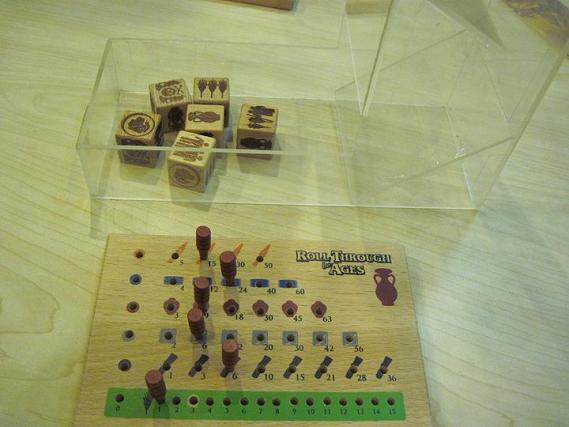18 Oct

Obviously, many trees were hurt in the making of this game.
Some thoughts on this filler game that we closed a recent session with. Amusingly enough, it seems that its name really is derived from Through the Ages, though I don’t think that the game are similar beyond sharing the same Civilization theme.
- It’s a game with wooden dice, wooden player boards with holes for pegs and most surprisingly, a big stack of score sheets as you need one per player per game. Wow, that’s a lot of dead trees! Jokes aside, it’s the first time I’ve seen a game use a score sheet so extensively. While I can see why it’s necessary in this game (lots of things to track), I still think it’s very inelegant. Just design a nifty board so that you can keep track of everything in one place already!
- You roll dice to get the resources shown on the die faces and you even get to set some results aside and reroll the other ones, up to three times. The only exception is that you must set aside the die results with crossbones on them, and getting enough of them triggers bad stuff, either for you or for your opponents. Appropriately enough, the classic Civilization unit of production is turned into dice in this game. The more cities you have, the more dice you can roll and the more resources you can potentially generate. But each city also imposes an upkeep cost in the form of food.
- The spend those resources to get things done, which usually translates to points. You use people to found new cities and build monuments. You spend money, including money gained from building resources, to buy technology. Food is of course used to pay for upkeep. The game ends when any one player has bought five technological advances.
- In our game, both Shan and Sean had nicely humming civilizations as they competed to found ever more cities and complete monuments. In the meantime, I kept rolling lots of crossbones results which everyone interpreted as bad news because I kept losing points because of them, I couldn’t get enough food to feed my cities and I couldn’t get people to grow more cities or build monuments either. On the other hand, I kept piling up resources and early on only bought the technological advance that removes resource accumulation limits and to mitigate the effects of rolling two crossbones results.
- Surprisingly, I ended up winning the game because I managed to buy the two most expensive technologies in my last two rounds, despite having fewer cities and almost no monuments. Sean came in dead last as he had invested a lot of manpower in building a huge monument but Shan chose to end the game before he could finish it.
- I guess this nicely demonstrates that there are multiple paths to victory in this game. What the two of them should have done, when they noticed me accumulating resources, should be to buy cheap technologies in an effort to end the game before I get too much money. The end of the game is very much under the control of the various players.
- Still, I can’t say that I really like this game. It’s a bit too straightforward for me and I don’t like the mechanic of allowing the player to selectively reroll dice to get what he wants. As dice games go, I very much prefer both Airships and Kingsburg.
Written on October 18 2010 and is filed under Boardgames.
You can follow any responses to this entry through the RSS 2.0 feed.
You can leave a response, or trackback from your own site.
Leave a Reply